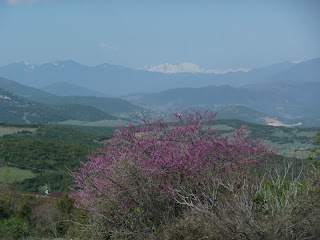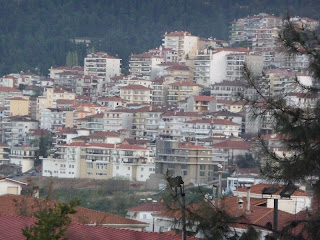March 31, 2012
We got up at 6:00 a.m., got ready for the day, and went to breakfast at 6:45 a.m. We loaded onto the bus at 7:30 a.m. and started our day of touring. Today we headed north to see the Monasteries of Meteora, Berea, and ended the day in Thessaloniki.
Marathon Lake: The Battle of Marathon took place in 490 B.C., during the first Persian invasion of Greece. It was fought between the citizens of Athens and a Persian force. The Athenians marched to Marathon, and succeeded in blocking the two exits from the plain of Marathon. A stalemate ensued for five days, before the Athenians decided to attack the Persians. The defeat at Marathon marked the end of the first Persian invasion of Greece, and the Persian force retreated to Asia. The Battle of Marathon is perhaps now more famous as the inspiration for the Marathon race. Although historically inaccurate, the legend of the Greek messenger Pheidippides running to Athens with news of the victory became the inspiration for this athletic event.
When the idea of a modern Olympics became a reality at the end of the 19th century, the organizers were looking for a great popularizing event, recalling the ancient glory of Greece. The idea of organizing a 'marathon race' came from Michel Breal, who wanted the event to feature in the first modern Olympic Games in 1896 in Athens. This idea was heavily supported. This would echo the legendary version of events, with the competitors running from Marathon to Athens. So popular was this event that it quickly caught on, becoming a fixture at the Olympic games, with major cities staging their own annual events. The distance eventually became fixed at 26 miles 385 yards, though for the first years it was variable, being around 25 miles the approximate distance from Marathon to Athens. (Wikipedia)
Kind of cool to learn how a "marathon" came to be...
The drive north was quite beautiful!
The group in the back of the bus snoozed a lot of the way...
300 Spartans: The Battle of Thermopylae was fought between an alliance of Greek city-states, led by King Leonidas of Sparta, and the Persian Empire of Xerxes I over the course of three days, during the second Persian invasion of Greece. It took place in August or September 480 B.C., at the narrow coastal pass of Thermopylae. (The road approximates where the coastline was at that time) A Greek force of approximately 7,000 men marched north to block the pass in the summer of 480 B.C. The Persian army, alleged by the ancient sources to have numbered over one million but today considered to have been much smaller (various figures are given by scholars ranging between about 100,000 and 300,000), arrived at the pass in late August or early September. Vastly outnumbered, the Greeks held off the Persians for seven days in total (including three of battle), before the rear-guard was annihilated in one of history's most famous last stands. During two full days of battle, the small force led by King Leonidas I of Sparta blocked the only road by which the massive Persian army could pass. After the second day of battle, a local resident named Ephialtes betrayed the Greeks by revealing a small path that led behind the Greek lines. Aware that his force was being outflanked, Leonidas dismissed the bulk of the Greek army, and remained to guard the rear with 300 Spartans, 700 Thespians, 400 Thebans and perhaps a few hundred others, the vast majority of whom were killed. (Wikipedia)
Greek Orthodox Church
We arrived in Kalambaka near the Monasteries of Meteora just in time for lunch. Most of us ate at the Meteora Restaurant. The food was pretty good. You got a plate and walked through the kitchen pointing out what you would like to eat from the big pots of food. It was very casual. We sat outside and ate. It was a beautiful day and we had a nice view of the huge rocks!
The Monesteries of Meteora: The Metéora is one of the largest and most important complexes of Eastern Orthodox monasteries in Greece, second only to Mount Athos. The six monasteries are built on natural sandstone rock pillars. The nearest town is Kalambaka. The Theopetra caves 3.1 miles south of Meteora had inhabitants fifty millennia ago. The cave of Theopetra, Kalambaka, radiocarbon evidence for 50,000 years of human presence. In the 9th century, an ascetic group of hermit monks moved up to the ancient pinnacles. They were the first people to inhabit Metéora. They lived in hollows and fissures in the rock towers, some of which reach 1800 ft above the plains. The exact date of the establishment of the monasteries is unknown. By the end of the 12th century, an ascetic community had flocked to Metéora. At the end of the 14th century, the Byzantine Empire's 800-year reign over northern Greece was being increasingly threatened by Turkish raiders who wanted control over the fertile plain of Thessaly. The hermit monks, seeking a retreat from the expanding Turkish occupation, found the inaccessible rock pillars of Meteora to be an ideal refuge. More than 20 monasteries were built, beginning in the 14th century. Six remain today. Access to the monasteries was originally (and deliberately) difficult, requiring either long ladders lashed together or large nets used to haul up both goods and people. (Wikipedia)
Monastery of St. Nicholas Anapafsas
view from the road up to the monasteries
Monastery of All Saints Varlaam
Monastery of All Saints Varlaam- there were kitties even here...
another gorgeous view!
Brenda and myself with the Monastery of All Saints Varlaam behind us
The Monastery of the Transfiguration
We were able to tour part of the Monastery of All Saints Varlaam. The women had to have skirts on in order to enter (since most of us did not bring skirts, they had wrap around skirts you could borrow - we all made such a great fashion statement). Here is Brenda making herself presentable...
Nani, our guide, showed us the basket they used (and still use sometimes) to bring up supplies and people. You can see in the 2nd picture that it was quite a ride in that basket to the top! The 3rd picture is looking down from the top. Thank goodness, they have put in steps for us to walk in order to access the monastery! It was a lot of steep steps, though!!
The views from the monastery were beautiful!
Here I am in my fancy skirt!!
It is quite incredible to me that the monks could build these beautiful, huge buildings on the tops of the rocks!!! It was quite a sight!
These are the steps we took...
After leaving the monasteries, we continued our drive to Berea. We drove along the mountains. It was beautiful. They recently built a new highway - Ignatio- which follows the old Roman roads. The highway cuts through the mountains. At one point, we went through 11 tunnels in succession!
Our last stop of the day was Berea where St. Paul preached. Berea was a very beautiful town! I really liked it! It has a population of about 30,000.
In 168 B.C. the Romans defeated Macedonia and made Berea the capitol of one of the four republics into which they divided the kingdom. In addition to the Macedonians, a fairly large number of Romans and Jews lived in Berea. Around 50 A.D. the apostle Paul visited Berea and, according to custom, went into the synagogue of the Jews. Here, no doubt to his surprise, he found that these Jews were more "fair minded" than their brethren in Thessalonica, for they "received the word with all readiness, and searched the Scriptures daily" to find out if the things Paul preached were true (Acts 17:11). As a result of their study of the Scriptures, "many of them believed, and also not a few of the Greeks, prominent women as well as men" (Acts 17:12). (www.padfield.com)
In Berea today you can see The Altar of the Apostle Paul, a modern monument the Bereans erected to remind them of Paul's visit to their city nearly 2,000 years ago.
Brother David read from the Scriptures and said a few words...
Then it was on to Thessoloniki where we will spend 2 nights. We were supposed to arrive there and eat dinner at 8:00 p.m. But we got behind schedule. Today was a long day and we traveled quite a distance. We arrived at the hotel around 8:40 p.m. and went right into dinner. We ate with Stan and Linda. There was a nice buffet dinner set out for us. I did not eat much as I was not very hungry - mostly just very tired. After dinner, we took our luggage to our rooms and crashed for the night. The hotel was very, very nice, had great rooms, but the beds were extremely hard!









































No comments:
Post a Comment